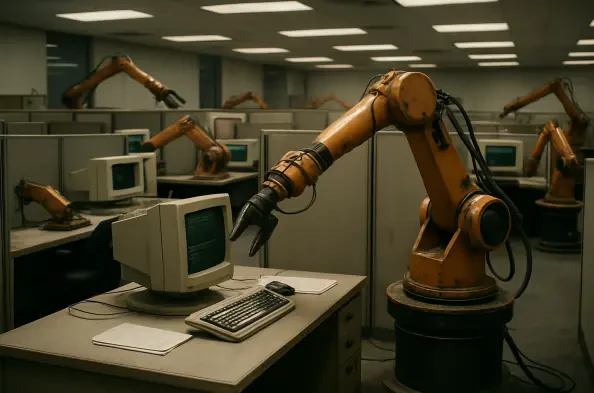Setting the Stage: A Workforce on the Brink of Transformation
Imagine a corporate landscape where entry-level roles vanish overnight, replaced by algorithms that draft reports, analyze data, and even brainstorm ideas with uncanny precision. This isn’t science fiction but the reality unfolding across industries as Artificial Intelligence (AI), particularly Generative AI (GenAI), reshapes the workplace. With businesses racing to adopt automation for cost savings and efficiency, a hidden threat emerges: AI atrophy, the erosion of human skills and organizational resilience due to over-reliance on technology. This market analysis delves into the profound risks automation poses to career structures, cognitive capabilities, and strategic stability, while projecting trends and offering actionable insights. The stakes are high as companies balance short-term gains against long-term sustainability in a rapidly automating world.
Market Trends: The Accelerating Shift to AI-Driven Workplaces
Adoption Surge Across Sectors
The integration of AI into workplace operations is witnessing explosive growth, with sectors like customer service, software development, and financial services leading the charge. Companies are leveraging GenAI to automate repetitive tasks, from drafting customer responses to coding basic applications, driven by the promise of slashing operational costs. A recent industry survey indicates that over 70% of firms in these sectors plan to transition entry-level roles from content creation to output review within the next two years, signaling a seismic shift in job functions. This trend is fueled by the accessibility of AI tools, which are becoming increasingly user-friendly and cost-effective, allowing even small-to-medium enterprises to jump on the automation bandwagon.
Structural Evolution in Organizational Models
As automation proliferates, traditional corporate hierarchies are morphing into unconventional shapes, such as diamond and hourglass models. In the diamond structure, AI eliminates many junior positions, bloating middle management to oversee automated outputs, while the hourglass model empowers a smaller junior staff with AI tools, shrinking middle layers and expanding senior roles. This restructuring is evident in tech-heavy industries where firms report a 30% reduction in entry-level hiring since adopting AI systems. The implication is a market-wide disruption of the conventional career ladder, raising concerns about how future leaders will emerge without foundational experience.
Investment in AI Outpacing Human Capital Development
A stark imbalance is emerging in corporate spending, with investments in AI technologies far outstripping allocations for employee training and upskilling. Market data reveals that while AI implementation budgets have surged by 40% over the past year, only 15% of companies have corresponding programs to enhance critical thinking or data literacy among staff. This trend underscores a short-sighted focus on immediate efficiency gains, particularly in competitive sectors like consulting and logistics, where firms prioritize quarterly results over long-term workforce readiness. The gap signals a potential crisis in human capital, as skills atrophy under the shadow of automation.
Data Deep Dive: Quantifying the Risks of AI Atrophy
Career Progression Disruptions
Quantitative analysis paints a troubling picture of career pathways in an AI-dominated market. With entry-level roles diminishing—projected to drop by 25% across key industries by 2027—opportunities for hands-on learning are evaporating. Historically, these positions served as training grounds where employees honed skills through practical experience, preparing for supervisory and leadership roles. Without this foundation, the talent pipeline for middle and senior management is at risk, with some analysts predicting a 20% shortfall in qualified leaders within the next five years if current trends persist. Industries reliant on nuanced decision-making, such as healthcare and legal services, face heightened exposure to this gap.
Cognitive Impact Metrics
Beyond structural shifts, the cognitive toll of AI reliance is becoming measurable. Studies from leading tech research firms show a correlation between heavy AI usage for analytical tasks and a decline in independent problem-solving abilities among employees, with a reported 18% drop in critical thinking metrics over recent assessments. This phenomenon, often termed cognitive offloading, is particularly pronounced in sectors like marketing, where teams increasingly depend on AI for campaign ideation and data interpretation. The market implication is a workforce less equipped to question or correct AI outputs, potentially amplifying errors in automated processes.
Strategic Vulnerability Indicators
Strategically, over-dependence on AI systems without human oversight—sometimes referred to as the “Pakled Problem” in industry discussions—poses a significant risk. Data suggests that 60% of companies in tech-driven markets lack contingency plans for AI system failures, leaving them vulnerable to operational disruptions. This issue is compounded by a shrinking pool of employees with deep technical understanding, as training programs fail to keep pace with automation’s complexity. Sectors with high regulatory oversight, such as finance, face additional challenges, as compliance demands human judgment that cannot be fully delegated to algorithms.
Future Projections: Navigating the Automation Trajectory
Rapid Expansion with Regulatory Checks
Looking ahead, the market for workplace AI is poised for rapid expansion, with adoption rates expected to climb by 35% across industries by 2027. Innovations like agentic AI, capable of autonomous decision-making, are set to penetrate even strategic roles, particularly in manufacturing and retail. However, economic pressures and increasing regulatory scrutiny may temper this growth, as governments push for frameworks to protect jobs and ensure ethical AI use. Markets in regions with stringent labor laws are likely to see slower adoption, creating a patchwork of automation maturity globally.
Hybrid Models as the New Norm
Projections indicate that hybrid work models, blending AI efficiency with human creativity, will dominate the future landscape. Analysts anticipate that 80% of forward-thinking firms will adopt such models within the next three years, prioritizing systems where AI handles routine tasks while humans focus on innovation and oversight. This shift will be critical in industries like education technology, where personalized learning tools must be balanced with human empathy. Success will hinge on substantial investments in upskilling, with leading companies already piloting programs to integrate critical thinking into AI workflows.
Risk of Widening Skill Gaps
A concerning forecast is the widening skill gap if proactive measures are not taken. Without intervention, the disparity between AI-savvy employees and those sidelined by automation could grow, with estimates suggesting a 30% increase in workforce inequality by the end of the decade. This trend risks creating a bifurcated market where only a small elite can navigate complex AI systems, while others struggle with diminished roles. Sectors with high automation potential, such as transportation, must address this through targeted training to prevent social and economic fallout.
Reflecting on the Path Forward: Strategic Takeaways
Looking back, this analysis highlighted the multifaceted risks of AI atrophy in the workplace, from disrupted career ladders to cognitive decline and strategic vulnerabilities. The market trends revealed an aggressive push toward automation, often at the expense of human capital development, while data underscored the tangible impacts on skills and readiness. Projections painted a future of rapid AI expansion tempered by hybrid solutions and regulatory oversight. Moving forward, businesses must pivot to a balanced approach, investing in robust training programs to foster data literacy and critical assessment skills. Designing systems that prioritize human judgment over blind reliance on AI outputs should be a cornerstone of strategic planning. By embedding these principles, companies can harness automation’s benefits while safeguarding the human ingenuity that drives lasting innovation.






